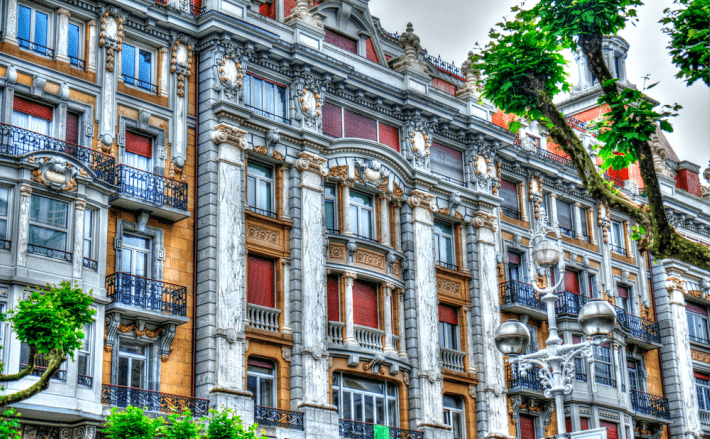San Sebastián and Barcelona are spearheading growth at the top end of Spain’s property market. But the crème de la crème of Spanish property doesn’t come cheap…
Property in beach resorts along Spain’s sunny Costas represents great value for money. Head into certain Spanish cities, however, and you might be surprised how expensive Spanish homes can be.
A survey by an international estate agency shows that San Sebastián in the north-west is home to Spain’s most expensive street, as well as two others in the top five. Top of the table is Hernani Street, where property costs €12,700 (circa £10,800) per square metre, having risen six per cent in the last year. Spacious apartments with large windows or terraces that open towards the famous La Concha Bay are the most exclusive properties in the city. Spain’s third most expensive street, Zubieta, is also in San Sebastián, commanding average prices of €11,500 (£9,800) per square metre, while the city’s Paseo Miraconcha is placed fifth.
Compared to London, Spain’s most expensive street remains comparatively cheap.
Capital of the Basque Region, San Sebastián is arguably Spain’s most ‘foodie’ city, boasting more Michelin-starred restaurants per square kilometre than anywhere else in the country, as well as a huge selection of its famous tapas, or ‘pintxos’, bars. It has a beautiful old town, stunning seafront and smart boutique shopping district.
Compared to London though, Spain’s most expensive street remains comparatively cheap. Recent reports revealed that the average price of property in Kensington and Chelsea, London’s most expensive borough, is £11,321 (circa €13,200) per square metre. Westminster isn’t much cheaper at £10,552 (circa €12,300).
Barcelona beats Madrid for price
Back in Spain, Pearson Avenue in Barcelona is the second most expensive place to buy a home, with prices reaching €12,000 (circa £10,300) per square metre, making it one of the fastest appreciating streets in the Catalan capital. Here you’ll find plenty of family houses and apartments of around 150 square metres with landscaped communal areas and multiple facilities. Barcelona is also home to Spain’s fourth priciest street, Paseo de Gracia (€11,000 per square metre), where properties most in demand are modernist buildings with high ceilings, terracotta tiles and large ornamental windows.
Most sought-after: large, renovated penthouses with high ceilings, next to Parque del Retiro.
Spain’s capital, Madrid, makes an appearance in fifth place – but third in terms of city – thanks to average prices in Serrano Street and Plaza Independencia being €10,000 (circa £8,500) per square metre. The most sought-after properties are renovated penthouses of around 250 square metres with high ceilings located next to Parque del Retiro, together with apartments in large stately, historic buildings.
Next up are Bilbao and Valencia. In the former, the most expensive properties are close to the iconic Guggenheim Museum located in the upmarket Euskadi Plaza where property achieves €5,600 (circa £4,800) per square metre. This figure is almost double what you pay for property in the best streets in Valencia, where prices slightly exceed €3,000 (circa £2,600) per square metre in Colón Street and Paseo de la Alameda.

San Sebastián in the north-west is home to Spain’s most expensive street.
Sellers’ market
Luxury homes are still a scarce commodity in many of the most exclusive areas of Spain. According to the estate agency that compiled the rankings, this shortage of supply, set against huge international demand, has led to increased prices in Spain’s major cities.
SEARCH for your property in Spain
This trend is expected to be maintained in the near future as the demand by European and American buyers seeking investment property continues. Price increases were around five per cent over the last year in the majority of Spain’s exclusive locations, but there was a double-digit rise in the most exclusive addresses in San Sebastián, specifically Hernani Street, and Valencia’s Colón Street.
One in eight city buyers were from overseas, mainly from Britain, Mexico, Venezuela, Germany and France
Most buyers in Spain’s five most expensive cities are domestic clients, said the agency, with one in eight buyers being international clients, mainly from Britain, Mexico, Venezuela, Germany and France. International investors opt for the Spanish capital because it offers higher returns than other major European cities, a situation that has encouraged many buyers from South America to change their investment preference from Miami to Madrid.
In Barcelona the percentage of domestic customers is close to 80 per cent and the remaining 20 per cent is mainly concentrated on overseas buyers from three main countries: Germany (with a total share of the overseas market of 15.8 per cent), France (14.4 per cent) and the Netherlands (13.2 per cent) followed by Italy, Switzerland, the UK and Argentina.
In San Sebastián, the gap narrows even more, with 70 per cent of property transactions undertaken by the Spanish market versus 30 per cent of overseas buyers, mainly from Australia, Canada and the Middle East.
In Valencia, the percentage of foreigners rises to 36 per cent, where mainly French and British buyers appreciate the true value of the Mediterranean lifestyle in a cosmopolitan city with a high quality of life and services, but with considerably lower prices than the other two major Spanish cities of Madrid and Barcelona.











